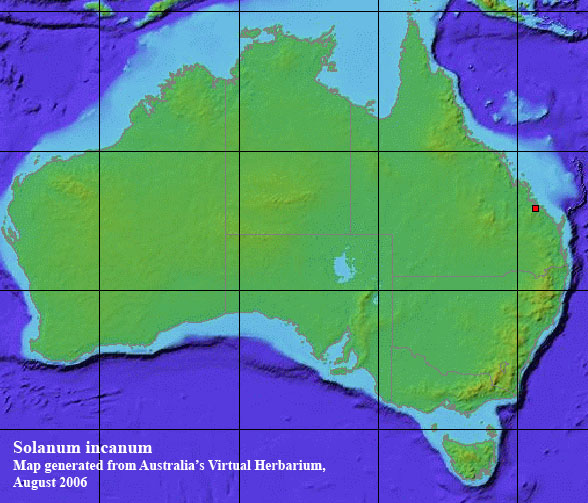
Synonymy
Solanum incanum L.,
T: Herb. J. Burser Vol. IX No. 20 (neo: UPS, fide Hepper & Jaeger,
Description
Erect, rhizomatous perennial shrub, 0.5-1.5 m high. Juvenile stage unknown. Adult branchlets brown or green; prickles 25-50 per dm, curved, broad-based, 3-7 mm long, 2-3 times longer than wide; stellae dense, 0.7-1 mm diameter, stalks 0-0.2 mm long; lateral rays 6-8, porrect; central ray 0.7-1.5 times as long as laterals, not gland-tipped; finger hairs absent; Type 2 hairs absent.
Adult leaves ovate or broadly ovate, shallowly lobed throughout; lobes 2 or 3 on each side, obtuse, lobing index 1.1-1.6; lamina 3.5-8.5 cm long, 2.3-5 cm wide, 1.5-1.7 times longer than broad, apex obtuse or acute, base cuneate or obtuse, oblique part 0-2 mm long, obliqueness index 0-2 percent; petioles 0.8-1.7 cm long, 20-30% length of lamina, prickles present. Upper leaf surface grey-green; prickles 3-11, straight, broad-based, 5-10 mm long, prickles present on mid-vein only or present on midvein and lateral veins; stellate hairs distributed throughout; proto-stellae absent; ordinary stellae density moderate to dense, 0.3-0.5 mm apart, 0.4-0.7 mm across, sessile; lateral rays 4-8, porrect; central ray 0.8-1.2 times as long as laterals, not gland-tipped; finger hairs absent; Type 2 hairs absent. Lower leaf surface green to white; prickles 5-15, straight, broad-based, prickles present on mid-vein only or present on mid-vein and lateral veins; stellae dense, 0.1-0.2 mm apart, 0.5-0.7 mm diameter, stalks 0-0.2 mm long; lateral rays 7 or 8, porrect; central ray 0.8-1.2 times as long as laterals, not gland-tipped; finger hairs absent; Type 2 hairs absent.
Inflorescence supra-axillary, solitary or pseudo-umbellate, common peduncle absent; 1-3-flowered, strongly andromonoecious, flowers 5-merous. Flowers markedly dimorphic, with larger pricklier basal flower(s); pedicels 5-10 mm long at anthesis, same thickness throughout, 0.4-1 mm thick at mid-point, prickles absent or present. Calyx prickles on basal bisexual flowers 10-30, 2-7 mm long; prickles absent from distal male flowers. Calyx tube 3-4 mm long, lobes deltate or rostrate, 1.5-2.5 mm long; stellae very dense, yellow or white, 0.6-0.8 mm across, stalks 0-0.2 mm long, lateral rays 7 or 8, central ray 0.8-1.2 times as long as laterals, not gland-tipped; finger hairs absent; Type 2 hairs absent. Corolla purple, 9-12 mm long, rotate, inner surface sparsely stellate-hairy; anthers 4.5-5 mm long; ovary with stellate and Type 2 hairs; functional style 6.5-7 mm long, erect, with stellate and Type 2 hairs, stellae 0.6-0.7 mm across, lateral rays c. 9, central ray 0.5-1 times as long as laterals.
Fruiting calyx with lobes less than half length of mature fruit, prickles 4-7 mm long. Mature fruits 1 per inflorescence, globular, 18-22 mm diameter, yellow, 2- locular; placenta in cross-section stalked, anvil-shaped; mesocarp moist but not juicy; exocarp c. 1 mm thick; pedicels 15-20 mm long in fruit, 0.8-1.2 mm thick at mid-point; seeds pale yellow or brown to black, 2-2.6 mm long.
Description by A.R.Bean, reproduced with permission from Austrobaileya 6: 801 (2004).
Another detailed description of this species can be found in the Bean interactive key to the eastern Australian species of Solanum at http://delta-intkey.com/solanum/www/incanum.htm
Distribution and ecology
S. incanum is native to Africa and only recently recognised for
S. incanum is found in disturbed areas.
Relationships
Treated as part of the S. incanum group of the subg. Leptostemonum (Whalen 1984), together with S. linnaeanum and S. marginatum. Bean (2004) also added S. stupefactum to this group.
Molecular studies by T.L.Weese & L.Bohs: Eggplant origins: out of Africa, into the Orient. Taxon 59: 49-56 (2010), confirm the close relationships between S. melongena, S. incanum and S. linnaeanum, but indicate a more distant relationship with S. marginatum.
From the web
A comprehensive fact sheet on S. incanum in
Numerous links to images of S. incanum (photos and herbarium specimens) can be seen on the Radboud University, Nijmegen (Netherlands) site. This garden specialises in maintaining the most extensive ex situ plant collection of non-tuberous species of Solanaceae.
Images of S. incanum are shown on the CalPhotos site and on the Flora of Zimbabwe site.
Further information about this species can be accessed through the Plants Profile site of the US Department of Agriculture.
Limited information and links for this species can be found on the Solanaceae Source site.